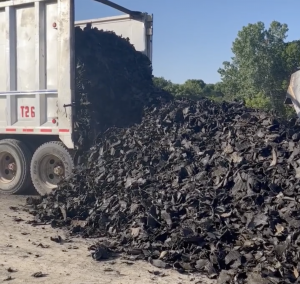Did you know every year nearly 300 million tires are discarded in the U.S. alone? That’s about one tire per person and one quarter of those tires end up in landfills.
What are Scrap Tires and Why Have They Become an Issue?
Tires are manufactured from vulcanized rubber with steel rubber woven through. For decades, tires have been dropped off at landfills and many tires have been dumped illegally along ditches and in fields, lakes, and rivers. Scrap tires have become a major problem because they are not biodegradable, meaning they won’t decompose by bacteria, so they aren’t just going to disappear. Not only are piles of scrap tires ugly, but they can cause health and environmental hazards. Tires contain toxic chemicals which are released into the air, ground, and water. They can even catch fire if left in the sun for long periods of time. When this happens, the tires break down into hazardous compounds including gases, heavy metals, and oil. This oil can seep into the ground and surface water which is a major environmental pollutant.
 How are Scrap Tires Being Reused?
How are Scrap Tires Being Reused?
Because of the environmental concerns that scrap tires pose, states have enacted legislation to manage and decrease the number of waste tires. Many states even offer incentives, rebates, and grants to companies that process and utilize scrap materials, like tires. Scrap tires nowadays are being used in so many innovative ways. End-of-life tires can be shredded to become tire derived aggregate, or TDA, which can be used by engineers for other applications including road repair, construction, landscaping, and in playgrounds. TDA is being used more and more because it has many characteristics that are beneficial for engineering use and is cost effective. Not only is it sustainable, but it is also durable, lightweight, and permeable.
Another way in which scrap tires are being reused is as a fuel source. Tire derived fuel, or TDF, is an alternative way to burning fossil fuels and produces 20% more energy than coal. Not only is TDF more efficient than coal, but it produces lower nitrogen oxide emissions decreasing the output of greenhouse gases. TDF is ideal for cement kilns, steel mills, and power plants because of its high thermal conductivity.
How Can I be a Part of the Solution?
You might be thinking to yourself, how can I help be a part of the solution to these problems? To reduce the number of scrap tires, you can make sure to practice good tire maintenance by keeping the proper air pressure in your tires and rotating them as recommended by the manufacturer. When purchasing new tires, look to buy tires with a longer tread-life. If you have old tires you wish to get rid of, contact your nearest tire recycling center or auto shop about dropping them off. Some cities and counties also host regular tire recycling events. By doing your best to increase the lives of your tires, you are helping to reduce the need for tire disposal.
Conclusion
Sometimes environmental issues feel like mountains but with creative ideas and working together we can make a difference! If we can find a sustainable solution for material like tires, what other environmental solutions can we think of?
For more information on the recycling of scrap tires, join the Into The Outdoors Adventure Team as they travel to Michigan, Colorado, and Minnesota to investigate sustainable solutions to scrap tires and learn how different organizations are making a difference.




